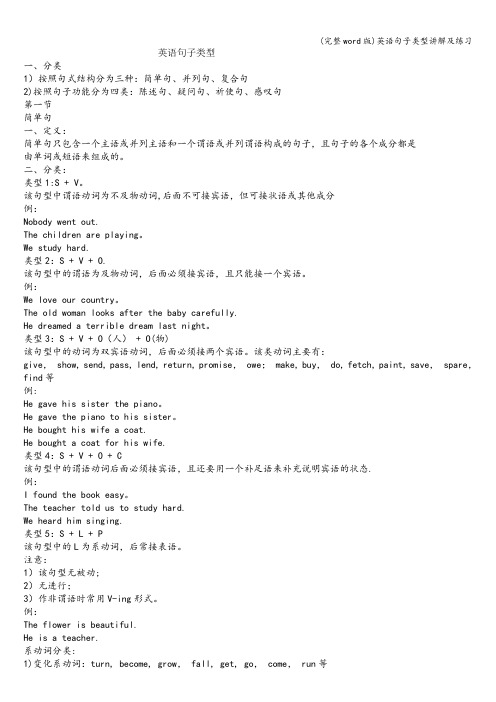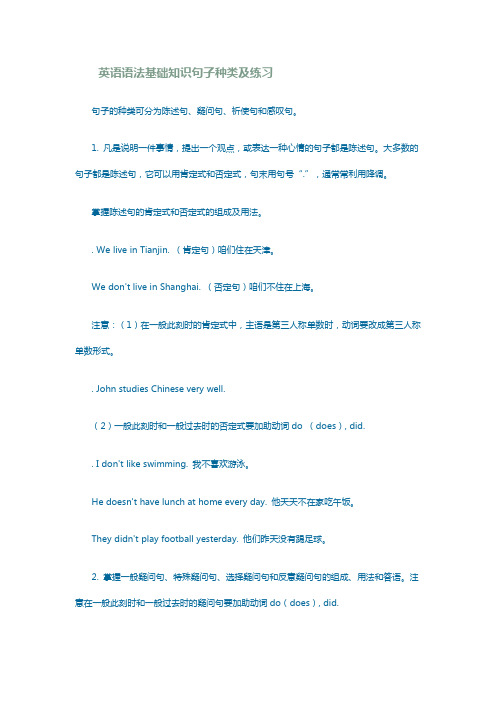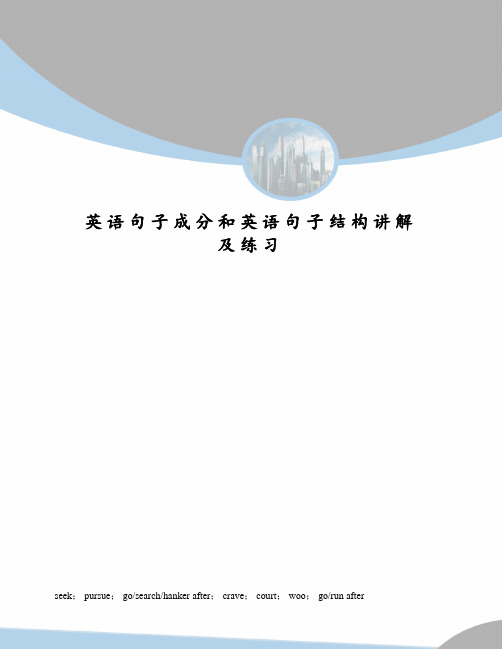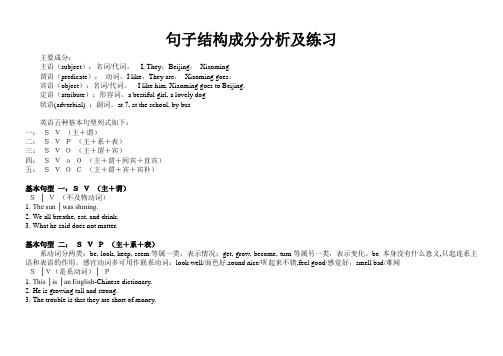英语句子类型讲解及练习
英语句子成分和英语句子结构讲解及练习

英语句子成分和英语句子结构讲解及练习英语句子就像一座建筑,句子成分是构成这座建筑的各种材料,而句子结构则是建筑的框架。
理解句子成分和结构对于我们正确理解和运用英语至关重要。
接下来,让我们一起深入探讨。
一、英语句子成分1、主语主语是句子所描述的主体,通常是某人、某事或某物。
它是句子的核心,决定了句子要说的是谁或什么。
比如,“The dog is cute” (这只狗很可爱。
)中,“The dog”就是主语。
2、谓语谓语表示主语的动作或状态。
它通常由动词构成。
例如,“She sings beautifully” (她唱歌很好听。
)中的“sings”就是谓语。
3、宾语宾语是动作的对象,通常是接受动作的人或物。
比如,“He bought a book” (他买了一本书。
)中的“a book”就是宾语。
4、表语表语用于说明主语的特征、状态、身份等。
常见的系动词有 be (am/is/are)、seem、look 等,其后的成分就是表语。
例如,“She is happy” (她很开心。
)中的“happy”就是表语。
5、定语定语用来修饰、限定名词或代词。
它可以是形容词、名词、代词、数词、介词短语等。
例如,“The red car is mine” (那辆红色的车是我的。
)中的“red”就是定语。
6、状语状语用于修饰动词、形容词、副词或整个句子,表示时间、地点、原因、方式、程度等。
比如,“He runs fast” (他跑得很快。
)中的“fast”就是状语。
7、补语补语用于补充说明宾语或主语的情况。
例如,“We made him our monitor” (我们选他当班长。
)中的“our monitor”就是宾语补足语。
二、英语句子结构1、简单句简单句只有一个主谓结构,是最基本的句子类型。
例如,“I love you” (我爱你。
)2、并列句并列句由两个或两个以上的简单句通过并列连词(and, but, or 等)连接而成。
英语句子成分及英语句子结构讲解及总结练习

英语句子成分和英语句子结构讲解及练习句子从结构上分:1.简单句2.并列句〔并列复合句〕3.复合句〔主从复合句〕1〕名词性从句:〔1〕主从(2)宾从 (3)表从 (4)同从2〕形容词性从句定从〔限定性的定语从句和非限定性的定语从句〕副词性从句〔状从〕简单句的五种根本句型五种句子的根本结构,主谓主谓宾主系表主谓双宾语〔间宾直宾〕主谓复合宾语〔宾+宾补〕主语〔subject〕:是执行句子的行为或动作的主体。
Thesunrisesintheeast. 〔名词〕Helikesdancing. 〔代词〕Twentyyearsisashorttimeinhistory.(数词)Seeingisbelieving. 〔动名词〕Toseeistobelieve. 〔不定式〕Whatheneedsisabook.〔主语从句〕Itisveryclearthattheelephantisroundandtalllikeatree.〔It形式主语,主语从句是真正主语〕谓语〔predicate〕:说明主语的动作、状态和特征。
WestudyEnglish. Helikesplayingthegames.表语〔predicative〕:系动词之后的成分,表示主语的性质、状态和特征。
Heisate acher.〔名词〕Fiveandfiveisten.〔数词〕Heisasl eep.〔形容词〕Hisfath erisin.〔副词〕Thepictureisonthewall.(介词短语)Mywatchisgone/missing/lost.〔形容词化的分词〕Towearafloweristos ay “I’mpoor,Ican〔不’定式tbuy〕aring.Thequestioniswhethertheywillcome .〔表语从句〕〔常见的系动词feel(摸起来,sound〔听起有:be来〕,look〔看起来〕,taste〔尝、吃起来〕,smell 〔闻起来〕keep,stay,remain〔保持,仍是〕get,become,turnfeel〔感觉〕...Itsoundsagoodidea.Thesoundsoundsstrange.Hervoicesoundsswee t.Tomlooksth in.Thefoodsmellsdelicious.Thefoodtastesgood.Thedoorremainsopen .NowIfeeltired.第1页共14页宾语:1〕动作的承受者-----动宾IlikeChina. 〔名词〕Hehatesyou.〔代词〕Howmanydoyouneed?Weneedtwo.〔数词〕Weshouldhelptheoldandthepoor.Ienjoyworkingwithyou. 〔动名词〕Ihopetoseeyouagain.〔不定式〕Didyouwritedownwhathesaid? 〔宾语从句〕2〕介词后的名词、代词和动名词-----介宾Areyouafraidofthesnake? Underthesnow,therearemanyrocks.3〕双宾语-----间宾〔指人〕和直宾〔指物〕Hegavemeabookyesterday. Givethepoormansomemoney.宾补:对宾语的补充,全称为宾语补足语。
(完整word版)英语句子类型讲解及练习

英语句子类型一、分类1)按照句式结构分为三种:简单句、并列句、复合句2)按照句子功能分为四类:陈述句、疑问句、祈使句、感叹句第一节简单句一、定义:简单句只包含一个主语或并列主语和一个谓语或并列谓语构成的句子,且句子的各个成分都是由单词或短语来组成的。
二、分类:类型1:S + V。
该句型中谓语动词为不及物动词,后面不可接宾语,但可接状语或其他成分例:Nobody went out.The children are playing。
We study hard.类型2:S + V + O.该句型中的谓语为及物动词,后面必须接宾语,且只能接一个宾语。
例:We love our country。
The old woman looks after the baby carefully.He dreamed a terrible dream last night。
类型3:S + V + O(人) + O(物)该句型中的动词为双宾语动词,后面必须接两个宾语。
该类动词主要有:give, show, send, pass, lend, return, promise, owe; make, buy, do, fetch, paint, save, spare,find等例:He gave his sister the piano。
He gave the piano to his sister。
He bought his wife a coat.He bought a coat for his wife.类型4:S + V + O + C该句型中的谓语动词后面必须接宾语,且还要用一个补足语来补充说明宾语的状态.例:I found the book easy。
The teacher told us to study hard.We heard him singing.类型5:S + L + P该句型中的L为系动词,后常接表语。
英语语法基础知识句子种类及练习

英语语法基础知识句子种类及练习句子的种类可分为陈述句、疑问句、祈使句和感叹句。
1. 凡是说明一件事情,提出一个观点,或表达一种心情的句子都是陈述句。
大多数的句子都是陈述句,它可以用肯定式和否定式,句末用句号“.”,通常常利用降调。
掌握陈述句的肯定式和否定式的组成及用法。
. We live in Tianjin. (肯定句)咱们住在天津。
We don't live in Shanghai. (否定句)咱们不住在上海。
注意:(1)在一般此刻时的肯定式中,主语是第三人称单数时,动词要改成第三人称单数形式。
. John studies Chinese very well.(2)一般此刻时和一般过去时的否定式要加助动词do (does), did.. I don't like swimming. 我不喜欢游泳。
He doesn't have lunch at home every day. 他天天不在家吃午饭。
They didn't play football yesterday. 他们昨天没有踢足球。
2. 掌握一般疑问句、特殊疑问句、选择疑问句和反意疑问句的组成、用法和答语。
注意在一般此刻时和一般过去时的疑问句要加助动词do(does), did.. Do you often speak English at school ? 在学校你常讲英语吗?Does she have a brother ? = Has she got a brother ? 她有兄弟吗?Did it take you two hours to do your homework last night ?昨天晚上做作业花了你2个小时吗?What do you often do on Sundays ?礼拜日你常常干什么?When does your father get up every morning ?你父亲天天早晨几点钟起床?Why didn't your teacher come to school yesterday ?昨天你们的老师为何没来学校呢?提出两种或两种以上的情况,要求对方选择一种,这种疑问句叫选择疑问句。
英语句子成分讲解及练习

连系动词。
谓语, 才能表达完整的意思。这类动词叫做
一个表明主语身份或状态的表语构成复合
动词都不能表达一个完整的意思, 必须加上
此句型的句子有一个共同的特点: 句子谓语
D
C
B
A
E
基本句型四:SVP(主+系+表)
系动词分两类: be, look, keep, seem等, 表情况;
get, grow, become, turn等属另一类, 表变化。
五年前我住在北京。
4.五年前我住在北京。 5秋天有些鸟飞到南方去。 6.我的爷爷早晨起得很早。 7. 每天下午有许多学生到图书馆来借书。
I lived in Beijing five years ago.
In autumn, some birds fly to the south.
4.他们成功地完成了计划。 5.那位先生能流利地说三种语言。 6.我收到了笔友从澳大利亚寄来的信。 7.Jim 还不会自己穿衣服。
They have carried out the plan successfully.
That gentleman can speak three languages fluently.
01
Wait a minute.(名词)
02
巩固练习: 1.她昨天回家很晚。 2.会议将持续两个小时。 3.在过去的十年里,我的家乡已经发生了巨大。
The meeting will last two hours.
Great changes have taken place in my home town in the past ten years.
He showed the ticket to the conductor.
初中英语句子结构和句型分析及细致讲解

初中英语句子结构和句型分析及细致讲解初中英语句子结构和句型是学习英语的基础。
下面我将为你详细讲解,并配以丰富的例句,帮助你更好地理解。
初中英语句子结构及句型详解一、句子成分英语句子主要由以下成分组成:•主语(Subject):句子所陈述的主体,通常是名词或代词。
例:I like apples.(我喜欢苹果。
)•谓语(Predicate):表示主语的动作或状态,通常是动词。
例:She is reading a book.(她正在看书。
)•宾语(Object):动作的承受者,通常是名词或代词。
例:He bought a car.(他买了一辆车。
)•定语(Adjective):修饰名词或代词,表示其性质或特征。
例:This is a beautiful flower.(这是一朵美丽的花。
)•状语(Adverb):修饰动词、形容词或副词,表示时间、地点、方式等。
例:He runs very fast.(他跑得很快。
)•补语(Complement):补充说明主语或宾语的状态或特征。
例:They made him happy.(他们使他高兴。
)二、句子种类根据句子结构和意义,英语句子可分为以下几类:•简单句(Simple Sentence):只有一个主谓结构的句子。
例:I like English.(我喜欢英语。
)•并列句(Compound Sentence):由两个或两个以上的简单句用并列连词(and, but, or等)连接而成。
例:I like apples, and she likes bananas.(我喜欢苹果,她喜欢香蕉。
)•复合句(Complex Sentence):由一个主句和一个或多个从句组成。
例:When I go home, I will do my homework.(当我回家时,我将做作业。
)三、句子类型•陈述句(Declarative Sentence):用来陈述事实或观点。
例:He is a student.(他是一个学生。
英语句子成分和英语句子结构讲解及练习

英语句子成分和英语句子结构讲解及练习seek; pursue; go/search/hanker after; crave; court; woo; go/run after英语句子成分和英语句子结构讲解及练习简单句的五个基本句型主语+不及物动词Shecame..主语+及物动词+宾语ShelikesEnglish.主语+系动词+主语补语Sheishappy.主语+动词+间接宾语+直接宾语ShegaveJohnabook.Sheboughtabookforme.主语+动词+宾语+宾语补语Shemakeshermotherangry.Theteacheraskedmetoreadthepassage.There+beThereliesabookonthedesk.主谓宾名/代--动词--名/代we--saw--you.we--did--thework.主系表名/代-系动词-形容次/名词/代词youarebeautifulyouseemsworried.youareastufent.相同点都三部分,主语也一样.不同动词和系动词,时态一样,否定式不同.动词加助动词,系动词不用.表语可以是形容词,宾语不行.只有宾语有补足语2、句子成分:英语句子成分分为七种:主语、谓语、宾语、定语、状语、表语、宾语补足语.1、主语是句子所要说的人或事物,回答是“谁”或者“什么”.通常用名词或代词担任.如:I’mMissGreen.我是格林小姐2、谓语动词说明主语的动作或状态,回答“做什么”.主要由动词担任.如:Jackcleanstheroomeveryday.杰克每天打扫房间3、表语在系动词之后,说明主语的身份或特征,回答是“什么”或者“怎么样”.通常由名词、代词或形容词担任.如:MynameisPingping.我的名字叫萍萍4、宾语表示及物动词的对象或结果,回答做的是“什么”.通常由名词或代词担任.如:Hecanspelltheword.他能拼这个词有些及物动词带有两个宾语,一个指物,一个指人.指物的叫直接宾语,指人的叫间接宾语.间接宾语一般放在直接宾语的前面.如:Hewrotemealetter.他给我写了一封信有时可把介词to或for加在间接宾语前构成短语,放在直接宾语后面,来强调间接宾语.如:Hewrotealettertome.他给我写了一封信5、定语修饰名词或代词,通常由形容词、代词、数词等担任.如:Shanghaiisabigcity.上海是个大城市6、状语用来修饰动词、形容词、副词,通常由副词担任.如:Heworkshard.他工作努力7、宾语补足语用来说明宾语怎么样或干什么,通常由形容词或动词充当.如:Theyusuallykeeptheirclassroomclean.他们通常让教室保持清洁/Heoftenhelpsmedomylessons.他常常帮我做功课/ TheteacherwantedmetolearnFrenchallbymyself.老师要我自学法语8☆同位语通常紧跟在名词、代词后面,进一步说明它的情况.如:WhereisyourclassmateTom你的同学汤姆在哪里1.主语subject:句子说明的人或事物.Thesunrisesintheeast名词Helikesdancing.代词Twentyyearsisashorttimeinhistory.数词Seeingisbelieving.动名词Toseeistobelieve.不定式Whatheneedsisabook.主语从句Itisveryclearthattheelephantisroundandtalllikeatree.It形式主语,主语从句是真正主语一指出下列句中主语的中心词①Theteacherwithtwoofhisstudentsiswalkingintotheclassroom.②Thereisanoldmancominghere.③Theusefuldictionarywasgivenbymymotherlastyear.④Todotoday'shomeworkwithouttheteacher'shelpisverydifficult.谓语predicate:是对主语加以陈述,表示主语的行为或状态,常用动词或者动词词组担任,放在主语的后面.WestudyEnglish.Heisasleep.二.选出句中谓语的中心词①Idon'tlikethepictureonthewall.A.don'tB.likeC.pictureD.wall②Thedaysgetlongerandlongerwhensummercomes.A.getB.longerC.daysD.summer③DoyouusuallygotoschoolbybusA.DouallyC.goD.bus④Therewillbeameetingatthelibrarythisafternoon.A.willbeB.meetingC.thelibraryD.afternoon3.表语predicative:系动词之后的成分,表示主语的性质、状态和特征.Heisateacher.名词Youdon’tlook it.代词Fiveandfiveisten.数词Heisasleep.形容词Hisfatherisin.副词Thepictureisonthewall.介词短语Mywatchisgone/missing/lost.形容词化的分词Thequestioniswhethertheywillcome.表语从句常见连系动词“存在”类:表示存在或具有某种特征或状态.这类连系动词强调“存在”.常见的有:be是,look看起来,feel摸上去,seem似乎是,appear似乎、显得,prove证明是,smell闻起来,taste尝起来,sound听起来等.例如:Thestorysoundstrue.Thoseorangestastegoodstar.2.“持续”类:表示某种情况或状态的持续.这类连系动词强调“持续”.常见的有:remain依然,keep保持,stay保持,continue继续、仍旧,stand处于某状况或情形等.例如:Whydon'tyouputthemeatinthefridgeItwillstayfreshforseveraldays.It'salreadyteninthemorning.Thestoreremainsclosed.What'sthematter3.“变化”类:表示由一种情况或状态变化成另一种情况或状态.这类连系动词强调“变化”后的情况或状态.常见的有:become变成,turn变成,grow变得,get变得等.例如:Putthefishinthefridge,oritwillgobadinhotweather.三挑出下列句中的表语①Theoldmanwasfeelingverytired.②WhyisheworriedaboutJim③Theleaveshaveturnedyellow.④SoonTheyallbecameinterestedinthesubject.⑤Shewasthefirsttolearnaboutit.①tired ②worried ③yellow ④interested ⑤first4.宾语:1动宾表示行为的对象,常由名词或者代词担任.放在及物动词或者介词之后.如:IlikeChina.名词Hehatesyou.代词Howmanydoyouneed Weneedtwo.数词Ienjoyworkingwithyou.动名词Ihopetoseeyouagain.不定式Didyouwritedownwhathesaid宾语从句2介词后的名词、代词和动名词-----介宾AreyouafraidofthesnakeUnderthesnow,therearemanyrocks.3双宾语-----间宾指人和直宾指物Hegavemeabookyesterday.Givethepoormansomemoney四挑出下列句中的宾语①Mybrotherhasn'tdonehishomework.②PeopleallovertheworldspeakEnglish.③Youmustpaygoodattentiontoyourpronunciation.④Howmanynewwordsdidyoulearnlastclass⑤Someofthestudentsintheschoolwanttogoswimming.hishomework ②English ③yourpronunciation ④newwords ⑤togoswimming5.宾补:对宾语的补充,全称为宾语补足语.Weelectedhimmonitor.名词Weallthinkitapity thatshedidn’tcomehere.名词Wewillmakethemhappy.形容词Wefoundnobodyin.副词Pleasemakeyourselfathome.介词短语Don’tlethim dothat.省to不定式Hisfatheradvisedhimtoteachthelazyboyalesson.带to不定式Don’tkeepthelights burning.现在分词I’llhavemybike repaired.过去分词扩展:主补:对主语的补充.Hewaselectedmonitor.Shewasfoundsinginginthenextroom.Hewasadvisedtoteachthelazyboyalesson.五挑出下列句中的宾语补足语①Shelikesthechildrentoreadnewspapersandbooksinthereading-room.②Heaskedhertotaketheboyoutofschool.③Shefounditdifficulttodothework.④TheycallmeLilysometimes.⑤IsawMr.Wanggetonthebus.⑥DidyouseeLiMingplayingfootballontheplaygroundjustnow①toreadnewspapersandbooksinthereading-room ②totaketheboyoutofschool ③Lily ④getonthebus ⑤playingfootballontheplayground划出句中的直接宾语和间接宾语①Pleasetellusastory.②Myfatherboughtanewbikeformelastweek.③Mr.Liisgoingtoteachushistorynextterm.④Hereisapen.GiveittoTom.⑤Didheleaveanymessageforme6.定语:修饰或限制名词或代词的词、词组或句子.Yanlingisachemistryteacher.名词Heisourfriend.代词Webelongtothethirdworld.数词Hewasadvisedtoteachthelazyboyalesson.形容词Themanoverthereismyoldfriend.副词Thewomanwithababyinherarmsismysister.介词TheboysplayingfootballareinClass2.现在分词Thetreesplantedlastyeararegrowingwellnow.过去分词Ihaveanideatodoitwell.不定式YoushoulddoeverythingthatIdo.定语从句六挑出下列句中的定语①TheyuseMr.,Mrs.withthefamilyname.②Whatisyourgivenname③OnthethirdlapareClass1andClass3.④Iamafraidsomepeopleforgottosweepthefloor.⑤Themandownstairswastryingtosleep.①family ②given ③third ④some ⑤downstairs7.状语:用来修饰v.,adj.,adv.,or句子.表示时间、地点、原因、目的、结果、程度、条件、方式和让步.以下例句按上述顺序排列Iwillgotheretomorrow.Themeetingwillbeheldinthemeetingroom.Themeatwentbadbecauseofthehotweather.HestudieshardtolearnEnglishwell.Hedidn’tstudyhard sothathefailedintheexam.Ilikesomeofyouverymuch.Ifyoustudyhard,youwillpasstheexam.Hegoestoschoolbybike.Thoughheisyoung,hecandoitwell.七挑出下列句中的状语①Therewasabigsmileonherface.②Everynightheheardthenoiseupstairs.③HebegantolearnEnglishwhenhewaseleven.④Themanonthemotorbikewastravellingtoofast.⑤Withthemedicineboxunderherarm,MissLihurriedoff.①ontheface ②Everynight ③whenhewaseleven ④fast ⑤Withthemedicineboxunderherarm 八、同位语当一个概念词在前,后面的词、词组或者句子是在解释前者时,而且两者的语法功能相同,后者就是前者的同位语.Mr.Black,ourEnglishteacher,isagoodtennisplayer.我们的英语老师——布莱克先生是个优秀的网球手.Football,theonlyinterestinlife,hasbroughthimmanyfriends.足球----他唯一的爱好,让他结交了许多朋友.YesterdayImetTom,afriendofmybrother's.昨天我遇到了我弟弟的朋友汤姆.That’sherhabit,readinginbed.躺在床上看书是她的习惯.Yoursuggestion,tostrikewhiletheironishot,seemedagoodidea.你建议趁热打铁,这个建议很好. Hegaveordersthattheworkshouldbestartedimmediately.他发出指示要立即开始工作.Youstillhaven’tansweredmyquestionwhyyoudidn’tcometoschoolyesterday.你还没有回答我昨天为什么没有上学.同位语从句常跟在某些名词后,对其作进一步的解释.这些名词包括:fact,doubt,idea,news,hope,indication,decision,possibility,assumption,suggestion,ques tion.这类从句常常有that引导,有时也可以用what,why,whether,when等引导.九插入语插入语是说话者对所表达的意思的补充、强调、解释或者说话的态度,其位置灵活常常用逗号或者破折号分开,并且在语法上不影响其他成份.1.插入语常以副词副词短语、形容词形容词短语、介词短语、短语等形式出现.1常见的副词及短语:indeed,surely,however,obviously,frankly,naturally,luckily/happilyforsb.certainly等.九■Therebe句型拓展:Therebe+句词词组”中,there为虚词,be后面的名词词组为句子的真正主语.该句式在使用时须注意如下几点:★Therebe句式表示“有”时,它表示一种存在关系,通常带有一个地点状语,意为“什么地方时候有……”.句式中的主语只能为表泛指的名词词组,此外,其主语还可以带前置或后置定语.例如:1.Thereisablackboardintheclassroom.2.Therearefiveminutestogo.3.Therearetwooldwomenwaitingforyouatthegate.★在正式文体中,该句式中be动词的单复数形式取决于以下两种情况:1该句式中只有一个主语,主语为单数时,be动词用单数;主语若为复数,be动词也用复数.2该句式中有几个并列主语,则按就近原则处理,即与靠近be动词的第一个主语保持一致.例如:1.Thereisroomforimprovement.2.Therearethreeapplesonthetable.3.Therewereonlytwopens,adictionaryandatextbookonthedesk.★“Therebe+主语+不定式”中,不定式可以有主动和被动两种形式,不过在口语中主动形式更为常见.例如:1.Thereisalettertotypetoday.2.Thereisnotimetolose.3.Therearemanythingstobedonenow.★Therebe句式中,be动词有各种变化形式.1be动词有时态变化,可以为一般现在时、一般过去时、现在完成时、过去完成时、将来时等.例如:1.Therearealotofpeopleinthemeeting-room.2.Therewaslittleleft.3.Therehavebeenmanysuchtrafficaccidentsinthepastfewyears.4.Whenhegotthere,hefoundtherehadbeennoonewaitingforhimintheroom.5.Withoutair,therewouldbenolivingthings.6.Thereisgoingtobeastormtomorrowmorning.2Therebe句式中,be之前可以有情态动词.例如:1.Theremaybesomepeoplewhodon’tlikethefilm.2.Thereusedtobeatempleinthevillage.句子种类一按使用目的可分为陈述句、疑问句、祈使句和感叹句.1陈述句DeclarativeSentences:说明一个事实或陈述一种看法. Lighttravelsfasterthansound.光比声速度快.Thefilmisratherboring.这部电影很乏味.Ihaven’tgotacamera.我没有相机.Theyhavenevermetbefore.他们以前从没见过面.疑问句InterrogativeSentences:提出问题.有以下四种:a.一般疑问句GeneralQuestions:Canyoufinishtheworkintime你能按时完成工作吗b.特殊疑问句WQuestions;HQuestionsWheredoyoulive 你住那儿Howdoyouknowthat 你怎么知道那件事c.选择疑问句AlternativeQuestions:Doyouwantteaorcoffee你是要茶还是要咖啡d.反意疑问句Tag-Questions:Heknowsher,doesn’the他不认识她,对不对=Doesheknowheryes,hedoes.No,hedoesn’t.3祈使句ImperativeSentences:提出请求,建议或发出命令,例如:Sitdown,please.请坐.Don'tbenervous别紧张4感叹句ExclamatorySentences:表示说话人惊奇、喜悦、愤怒等情绪,例如:Whatgoodnewsitis多好的消息啊HowgoodthenewsisWhatbeautifulflowerstheyare多美丽的花啊HowbeautifultheflowersareHowlovelythechildis多可爱的小孩啊Whatalovelychildheiswhatacutechildheis二句子按其结构可以分为以下三类:1简单句SimpleSentences:只包含一个主谓结构句子叫简单句,例如:Sheisfondofcollectingstamps.她喜欢集邮.Weallstudyhard.我们都努力学习.Ilovesportsverymuch.我非常喜欢运动.Mummadeabeautifulskirtforme.妈妈为我做了一条漂亮的裙子.Weelectedhimourclasspresident.我们选了他做班长.Therearemorethan3000studentsinourschool.我们学校的学生超过3000名.2并列句CompoundSentences:由两个或两个以上的简单句并列连接起来的句子叫并列句. Thefoodwasgood,buthehadlittleappetite.食物很精美,但他却没什么胃口.Let’shurry,orwewillbelate.咱们赶紧点,要不就迟到啦.Hestudiedhard,andhepassedtheexam.他努力学习并通过了考试.Hefeltnofear,forhewasverybrave.他很勇敢,毫不畏惧.Hewassick,sotheywerequiet.他病了,所以他们很安静.3复合句ComplexSentences:包含一个主句从句和一个或几个从句的句子叫复合句,从句由从属连词引导,例如:Thefilmhadbegunwhenwegottothecinema.我们到达电影院的时候,电影已经开演了.Doyouknowthemanwhoisinthecar你认识坐在汽车里的人吗Whathesaidisnottrue.他说的不是实话.Iknowit’sdifficulttomasteraforeignlanguage.我知道学好一门外语不容易.Thequestioniswhetherhewilljoinusnexttime.问题是下次他是否跟我们一起干. TheideathatIraqcouldbetakenwithinaweekortwowasanunderestimation.伊拉克可以在一两周内就可以拿下的这一想法是估计不足的想法.Togetintouniversity=Ifyouwanttogetintouniversityyouhavetopassanumberofexams.进入大学,你必须通过一系列的考试.元音和辅音的定义:发音时声带振动,呼出的气流通过口腔时不受阻碍,这样形成的语音称为元音.不论声带振动与否,发音时呼出的气流通过口腔或鼻腔时受到一定的阻碍,这样形成的语音称为辅音.发音时声带不振动的辅音称为清辅音.发音声带振动的辅音称为浊辅音.巧记48个国际音标单元音共十二,四二六前中后双元音也好背,合口集中八个辅音共计二十八八对一清又七浊,四个连对也包括.有气无声清辅音,有声无气浊辅音,发音特点应掌握1.音标必须写在括号里,常用的音标括号有斜头和平头两种,其上端不顶第一线,大致与大写字母相齐,下端在第三格的中2.音标没有书写体,也没有大小写,因此书写时必须和印刷体一样,直上直下,没有斜度,其书写规格如下所列.3.下面几个音标是最容易写错的,一定要注意:ai和au不要写成Ai和Au,A:不要写成a:.在打字的时候,不要用a来代替A,把A:打成a:,也不要用g来代替G,把GE:l打成gE:l.4.音标没有书写体,也没有大小写,因此书写时必须和印刷体一样,直上直下,没有斜度,其书写规格如下页所列元音音标学习元音概述:元音是有噪音的语音.形成元音时,声带振动,气流经由咽腔和口腔逸出时,不受到任何阻碍,没有可以听得到的摩擦声.英语里共有20个元音单元音12个,双元音8个.•元音之间的差异,是由发音时各发音器官所采取的不同位置形成的.所谓“不同位置”,指的是舌头的高低与前后,牙床的开合程度,以及唇形的大小和圆扁.但其中决定的因素是舌头的位置:舌头是在口腔的前部、中部或者后部,决定所发的音是前元音、中元音还是后元音;舌身隆起的高度以及舌的哪一部分隆起最高,决定发出的元音是开口元音、半开元音、合口元音、还是半合元音.牙床开合的程度是由舌位的高低所决定的,而双唇的圆扁和大小对形成不同的元音也有相当的影响.因此,描述一个元音的发音部位,主要是描述它的舌位和唇形.Lesson1元音i:i:学习i:发这个音的字母和字母组合eeaeee:mebesheheweeveningee:sweetbeesweepsheepseesleepthreegreenea:meatleafseapeateacheatclean根据发音规则,圈出下列单词中元音字母组合发音相同的两个词.1.seatrainbeancat2.giftfeetteacherd3.pigstartreejeep4.sweetseafishthei发这个音的字母和字母组合ieyeyay•i:pigfishinfifteensixshipthin•e:beginbehindjacketbasketball•y:happyheavybusylorrycarrysunny•lovelystudythirstytwentythirtywindyrainy•ey:monkeymoney•ay:SundaySaturdayFriday根据发音规则,圈出每组中元音字母发音不相同的单词.•1.sofasitkicklip•2.inkgiftjamship•3.handpicturebigsister•4.hotlickpigjelly:发这个音的字母和字母组合erirurearorer:herservetermir:birdgirlskirtfirstdirtyskirtshirtur:nurseThursdayturtlepurplecurtainear:earlylearnor:wordworkworld根据发音规则,圈出每组中元音字母组合发音相同的单词.1.thirtybeerthirstywheat2.bankkinghernurse3.turtlebirdrabbitknee4.roomrunshirtterm发这个音的字母和字母组合ureeraroraeure:pictureer:teacherbrotherdinnerfathersisterar:sugaror:doctora:pandaaboutabovecamerasofaChina根据发音规则,找出发的2个单词写在后面的横线上.1.mothersofaroadsmile2.sitfathersisterfood3.hairdeertigerChina4.sugarsoonearleaderLesson2音标:u:u学习发这个音的字母和字母组合oao:foxcoffeedogshopdogdoctorlonga:watch根据发音规则,找出发:的2个单词写在后面的横线上.1.doctorteacherboxclothes2.coldzooclockdog3.lovebosslotviolin4.watchbeachfoxgirlu:发这个音的字母和字母组合ooouio:dowhowhoseoo:foodmoontooui:fruitjuiceu:rulerrude根据发音规则,找出不发u:的单词.1.juicemoonzoopanda2.toothbroomeyespoon3.headbootnoodlespool4.nooncoolbootwatchu发这个音的字母和字母组合ooouo:womanwolf•oo:lookgoodbookfootwoodu:bullbullet•根据发音规则,选出与其它单词元音发音不相同的单词.1.mouthbooklookpull2.pushtapesugarfoot3.woodkindwolfbull4.bulletwoodcookname四.写出单词或音标.•bru:m d: sit b:d•fut wi: dg ′sist •lookdowatergood•toofootclockfirst •worksisterdoctorsea•五.将下列单词与正确的音标用线连起来.•hot blu:•football huk •blue ki:shook futb:l kiss ht Lesson3音标a:Λe练习a:发这个音的字母和字母组合aarauear •a:grassglassclassplantdancefastfatherlastar:carstararmMarchgardendarkscarf au:laughauntear:heart•根据发音规则,圈出发a:的2个单词. 1.armlipdoctorcard•2.cloudcartgardengate3.ballscarfdarktiger•4.joblorryMarchparkΛ发这个音的字母和字母组合ouooouo:soncomecolourlovemoneyu:sunnutjumpgumbusbrushsupperusou:touchcousincountry•根据发音规则,找出每组中发Λ的单词.1.hearcupbedair2.voiceboyduckant3.vasecornbeargun4.cuteboymoneyher发这个音的字母和字母组合aa:dadcapcatbadapplebagflaghandrabbitantblackfathasstandratmap根据发音规则,找出每组中发的单词.1.ratbedfacesport2.hearcupfatpear3.ricebatfingertree4.seayoungknifeapplee发这个音的字母和字母组合eeae:eggbelldesklegpettenpenea:breadheadbreakfast•根据发音规则,找出每组中不发e的单词.1.catwelllegpen2.sweatmappetelephant3.eggtentalldesk4.breadheadbedtoy音标a:Λe练习•一.抄写音标,一个抄写5遍.•a::Λ:•:e:____•二.选出下列没有相同发音的词.•1.cararmfoodgarden•2.truejumpbuscut•3.bagshortmapflag•4.eggpenheadsmall•5.gotclockbelldog•6.rabbitbookwoodfoot•7.ratbatappleten•8.gunstarduckmoneg•三.写出单词或音标.•pa:stru:mswetsit•f tgtcΛpsh:t•bagcarbusbreadstarhead•四.选出下列每题中元音有几种读音,有一种读音的在里画☆,有两种读音的画△,有三种的画◇•1.hatfastcooklast•2.jeepdoorsungum•3.dadcaphandmap•4.starcarcutfrom•5.skirtsheepbirdher•五.改变下列单词的一个字母,使它变成另一个单词•like_________________交通工具•hat________________动物•lake________________食品•nice_______________数字•hot_________________用品•well_______________用品Lesson4元音音标eiaiiau练习ai发这个音的字母和字母组合iyieuy•i:kitebikenicetigerwriteknife•y:bycryflymyskytrywhy•ie:tiepie•uy:buy•根据发音规则,找出每组中发ai的2个单词.•1.ricegoodjamright•2.shipmineice-creammouse•3.cloudsittieeye•4.writesmalltenniskitei发这个音的字母和字母组合oioy•oi:oilboilcoin•oy:boytoy根据发音规则,找出每组中发i的2个单词.1.soilhearsoycold2.rabbitbedboynoise3.walkvoiseboilword4.teaenjoytoymilkau发这个音的字母和字母组合ouowou:housemousemouthtrousersow:flowercowhownowdown•根据发音规则,选出不发au的单词. 1.mousecloudarmclown2.teachertrouserscowmouth3.towndanceflowerhouse4.towerblousenowbaby四.把下列单词下正确的音标连接起来•bowbau•gatepai•traygeit•pietrei•poisonpizn五.看图、填空、标号•h___t→s__n→e____s__r→•r__l____→c__k___→m____thLesson5元音音标uieu的练习u发这个音的字母和字母组合ooaowo:noserosepoenoveroa:boatcoatsoapgoatow:showwindowsnowbowl根据发音规则,圈出每组中发u的2个单词. 1.coatgoattreeriver2.makewindowkniferoad3.yourwhiterowcoat4.boathennoselampi发这个音的字母和字母组合eareerear:earhearteareer:deerbeer根据发音规则,圈出每组中发i的1个单词.1.bearbeerfairtail2.noodlespairnearcome3.horseneartowerair4.ringkingherethreee发这个音的字母和字母组合airearair:hairchairpairear:pearbearwear根据发音规则,圈出每组中发e的1个单词.1.bearideapineappletail2.noodlespairclimbcome3.horsehousetowerair4.ringkingharethreeu发这个音的字母和字母组合oorourureoor:poorour:tourure:surepure根据发音规则,圈出每组中发u的1个单词.1.cleartouristpineappletail2.noodlespairclimbfury3.beardcuretowerair4.voicekingpureengineer辅音爆破音:ptkbdg摩擦音:fvszθe破擦音:trdrtsdzt∫t3鼻辅音:mnη舌侧音:1出现在元音之前叫作清晰舌边音2出现在辅音及单词末尾时叫作模糊舌边音半元音:擦音中气流较弱,摩擦较小,介于元音跟辅音之间的音wj •3∫•hrLesson6辅音音标pbtd练习p发这个音的字母和字母组合pppp:pianopandaparrotpetshipsheeppigstoppp:applehappy根据发音规则,圈出没有发p的单词.1.shipphonesleeppear2.pickpenbigpineapple3.taxiparrotsheeppig4.pandaponypettruckb发这个音的字母和字母组合bbbb:bookballbirdbigboybagbananabb:rubberrabbitcabbage根据发音规则,圈出发b的2个单词.1.cabgiftbeachlove2.petgodtubbed3.weatherboybusmake4.rabbitreaddressbabyt发这个音的字母和字母组合tttt:tableteataxicatratfatticketTt:buttermatter根据发音规则,圈出没有发t的1个单词.1.taxifatbagtoy2.hatticketteaduck3.pocketpacketcatraind发这个音的字母和字母组合dedd:duckseeddoordeskdayredheadbedreadcolded:smiledopenedplayed根据发音规则,圈出没有发d的1个单词.1.bedclotheshand2.dogcoldfive3.danceduckgrape音标pbtd练习一.抄写音标,一个抄写5遍.•p:b:t:d:_______二.选出下列没有相同发音的词•1.pearshipcoatpig•2.taxibeancabcabbage•3.hatseaticketwallet•4.seeddancehandfull•5.pickpensitpineapple•6.coldfinddoorchair•7.clothpurplepoolpush•8.eatfanquietset三.写出单词或音标.•p ndkΛtdi:pklaud•applepearrabbitread四.改变下列单词的一个字母,使它变成另一个单词.•short→_____________衣物sea→_________________感官动词•pet→______________蔬菜ten→___________________动物Lesson7辅音音标kgsz学习g发这个音的字母和字母组合gggg:glassgolfgetgirlbaggoatflaggg:egg根据发音规则,圈出发g的单词.gasdrivegumgiveviolinbagjeansorangelogbridgeguesstankgradelonglanguages发这个音的字母和字母组合scssces:starsunsnakeseaseec:pencilcitycedarceilingcelebratess:grassglassclassbossce:faceracericenice根据发音规则,圈出每组中2个发s的单词.1.whosejuicelickstudent2.thosecasescarfshoes3.spacenosesciencemeat4.tearspiecebusnoseLesson8辅音音标∫3t∫d3练习3发这个音的字母和字母组合ss:television,usually,Asiameasureagarage,anunusualcollision;agreatdecision;mypleasure根据发音规则,圈出下列单词中发3的2个单词.1.shellshipgaragedesk2.truckshirtpleasureship3.brushcasualsheepsleep4.heroshapeleisureshelft∫发这个音的字母和字母组合chtchch:teacherpeachcherrychairtch:watchmatch根据发音规则,找出下列单词中发t∫的单词,并抄下来. chairdumplingbeachcheesenightshemonkeyChinachurchtheseflowereggdreamsharkchickcatchLesson9音标fvθe的练习v发这个音的字母和字母组合vvev:videovasevestve:fiveloveviolin根据发音规则,在不发v的单词上打×violinmovevotewindowvanvolcanowhitewomanvictorywetwavevasee发这个音的字母和字母组合thth:fathermotherbrotherclothesweather根据发音规则,圈出每组中发e的1个单词. 1.thansisterbrotherthree2.weatherthanknightgood3.tielookteeththey4.thinfatherthroatwatchLesson10辅音音标tsdztrdr的练习dz发这个音的字母和字母组合dsdesds:seedswoodsfriendsbirdsbedsdes:rides根据发音规则,找出发dz的5个单词写在后面的横线上. coatshandscatskitesbedswordspetskidsseatshorsesandsgatestr发这个音的字母和字母组合trtr:treetrucktrousersstrawberrytrick根据发音规则,找出没有发tr的3个单词写在后面的横线上. seatstrucktraintrashtractordrinkstreetdrugtrousersdr发这个音的字母和字母组合drdr:drawdrinkdriverdragondry根据发音规则,找出每组中发dr的2个单词写在后面的横线上.1.dreamduckdressrain2.ratdraindrugdoor3.treetreasuredrawerdrink4.truckdragondishdrumLesson11辅音音标hrlm的练习r发这个音的字母和字母组合rrrwrr:riceroomrideroadroserr:mirrorcarrotparrotwr:writewrongwrap根据发音规则,选出发r的单词,打√.1.breaddriverwrongrainworker2.riverfatherrobotropesister3.writefruitrabbitcrowndruml发这个音的字母和字母组合lll•l:looklightlockluckyliontail•ll:ballpulldollartell根据发音规则,选出每组中不发l的单词.•mpnailflagwoman•2.yellowfruitlionlychee•3.grapebulllaughlake•4.dumplingmoonwheelwhaleLesson12音标nηwj的练习n发这个音的字母和字母组合nkngnn:nosenetnutbanananoodlestrainrainplanedownkn:kneeknifeknockgn:sign根据发音规则,找出发n的单词并抄下来.1.mirrorwheelyesknock2.mallhenlaughnut3.earringsplanewingbreadη发这个音的字母和字母组合nngn:inkbanktankfingerng:singhangsongkingreadingrunning根据发音规则,从下列每组中找出2个发η的单词. 1.netringfingermeat2.tennismouthsongswing3.dumplingwingrunnail4.hangswiminknotew发这个音的字母和字母组合w:winterwindowwatchwaterwellwouldwh:whitewherewhichwhenwhywheelwhale根据发音规则,选出每组中不发w音的1个单词.1.woodwritewheelwhich2.wheatsnowwetwoman3.whitewindownowwhy4.whalewaterwatchrowj发这个音的字母和字母组合yy:yo-yoyogurtyardyesyouyour根据发音规则,找出发j的单词写在下面横线上. cryyouyourskyyellowlorry moneyjellytoyboyyogurtsoy。
最基础的英语句子结构分析和练习,超简单实用!

句子结构成分分析及练习主要成分:主语(subject):名词/代词。
I, They,Beijing,Xiaoming谓语(predicate):动词。
I like,They are,Xiaoming goes,宾语(object):名词/代词。
I like him. Xiaoming goes to Beijing.定语(attribute):形容词。
a beatiful girl, a lovely dog状语(adverbial) :副词。
at 7, at the school, by bus英语五种基本句型列式如下:一:SV(主+谓)二:SVP(主+系+表)三:SVO(主+谓+宾)四:SVoO(主+谓+间宾+直宾)五:SVOC(主+谓+宾+宾补)基本句型一:SV(主+谓)S│ V(不及物动词)1.The sun │was shining.2.We all breathe, eat, and drink.3.What he said does not matter.基本句型二:SVP(主+系+表)系动词分两类:be, look, keep, seem等属一类,表示情况;get, grow, become, turn等属另一类,表示变化。
be 本身没有什么意义,只起连系主语和表语的作用。
感官动词多可用作联系动词:look well/面色好,sound nice/听起来不错,feel good/感觉好,smell bad/难闻S│V(是系动词)│ P1.This │is │an English-Chinese dictionary.2.He is growing tall and strong.3.The trouble is that they are short of money.There be 结构:There be 表示‘存在有’。
试比较:There is a boy there.(那儿有一个男孩。
- 1、下载文档前请自行甄别文档内容的完整性,平台不提供额外的编辑、内容补充、找答案等附加服务。
- 2、"仅部分预览"的文档,不可在线预览部分如存在完整性等问题,可反馈申请退款(可完整预览的文档不适用该条件!)。
- 3、如文档侵犯您的权益,请联系客服反馈,我们会尽快为您处理(人工客服工作时间:9:00-18:30)。
英语句子类型一、分类1)按照句式结构分为三种:简单句、并列句、复合句2)按照句子功能分为四类:陈述句、疑问句、祈使句、感叹句第一节简单句一、定义:简单句只包含一个主语或并列主语和一个谓语或并列谓语构成的句子,且句子的各个成分都是由单词或短语来组成的。
二、分类:类型1:S + V。
该句型中谓语动词为不及物动词,后面不可接宾语,但可接状语或其他成分例:Nobody went out.The children are playing.We study hard.类型2:S + V + O.该句型中的谓语为及物动词,后面必须接宾语,且只能接一个宾语。
例:We love our country.The old woman looks after the baby carefully.He dreamed a terrible dream last night.类型3:S + V + O(人) + O(物)该句型中的动词为双宾语动词,后面必须接两个宾语。
该类动词主要有:give, show, send, pass, lend, return, promise, owe; make, buy, do, fetch, paint, save, spare, find等例:He gave his sister the piano.He gave the piano to his sister.He bought his wife a coat.He bought a coat for his wife.类型4:S + V + O + C该句型中的谓语动词后面必须接宾语,且还要用一个补足语来补充说明宾语的状态。
例:I found the book easy.The teacher told us to study hard.We heard him singing.类型5:S + L + P该句型中的L为系动词,后常接表语。
注意:1)该句型无被动;2)无进行;3)作非谓语时常用V-ing形式。
例:The flower is beautiful.He is a teacher.系动词分类:1)变化系动词:turn, become, grow, fall, get, go, come, run等例:She becomes a lawyer.She turns lawyer.2)状态系动词:be, seem, remain, stay, stand, keep等例:He always kept silent at meeting.3)感官系动词:feel, smell, sound, taste, look, appear等例:The milk tastes sour.The cloth feels soft.4)终止性系动词:prove, turn out等例:His plan turned out a success.第二节句子成分在句子中起着不同语法作用的部分,叫做句子成分。
句子成分有9种: 主语、谓语动词、表语、宾语、定语、补语、状语、同位语、插入语。
1、主语(subject):表示句子描述的对象。
通常是谓语动词的动作执行者。
通常有名词、代词、数词、动词不定式、动名词、从句等充当。
The students worked very hard.They are from America.80% of the students in our class are girls.To learn English is very difficult for us.=It is difficult for us to learn English.Swimming in the lake is dangerous.What he said is true.2、谓语动词:主语的动作或具有的状态与特征。
构成形式如下:1)简单谓语:由一个动词或动词短语构成。
She practices speaking English every day.The woman takes good care of the baby.I have got rid of smoking.2)复合谓语形式1:由情态动词或助动词+动词构成。
You may gonow.He has caught a bad cold.We are going to visitthe old town tomorrow.3)复合谓语形式2:由系动词+表语构成。
We are studentsShe becomes famous.The little girlis afraid of the snake.4)复合谓语形式3:情态动词+系动词+表语It will be wasted.He must be wrong.We will be free tomorrow.5)复合谓语形式4:被动句的谓语动词。
Mary was seen to swim across the river.They were expected to finish the work as soon as possible.3、表语:用来说明主语的身份、特征和状态的成分。
一般在系动词之后。
表语可由下列结构充当:名词、代词、形容词、分词、数词、不定式、动名词、介词短语及表语从句。
The young man has turned thief.All of these are yours.The flower is beautiful.The film is moving.We are moved by the film.Her job is to look after the baby.My job is teaching English.Tom was out then.The fact is that he passed the exam successfully.4、宾语:表示动作承受的对象。
可由下列结构充当:名词、代词、数词、动名词、不定式、宾语从句等。
He bought a new car.The heavy snow prevented her from going to school.She enjoys listening to music.I don’t know how to get there.I think that he is old enough to join the army.5、宾补:英语中有少数及物动词后除了接一个宾语外,还必须有一个宾语补足语对宾语进行补充说明,这样才能使句子的意义完整,这类动词被称为“复合及物动词”,常见的动词有:make, consider, find, get, have, let等。
The boss made us work 14 hours every day.We found the dog lying on the ground.We painted our house white.We found him killed the next morning.6、定语:用来修饰限定名词或代词的词、短语或从句。
通常由下列结构充当:形容词、分词、名词,代词、数词、不定式、动名词、介词短语等。
She is a beautiful girl.My book is old.More than 30 students in our class are from abroad.He is the first to come and the last to leave.The teaching building is under construction.The girl in white is my sister.7、状语:用来修饰动词、形容词、副词或整个句子,说明动作或状态特征的句子成分。
通常由副词、介词短语、不定式、分词、名词、形容词或状语从句等充当。
She used to sit for hours quietly.He has lived in the countryside for 20 years.The tree is too tall for the boy to climb up.Encouraged by the teacher, she made up her mind to learn English well.Wherever you go, whatever you do, I will wait for you.8、同位语(appositive):对前面的名词或代词做进一步的解释,通常由名词、数词、代词或从句来充当。
This is Mr. Zhou, our headmaster.The question who should do the work is still in discussion.9、插入语(parenthesis):对一句话作一些附加的解释;通常由形容词、副词、介词短语、动词不定式、现在分词或从句来充当。
To be frank, I don’t quite agree with you.第三节并列句一、概念:有两个或两个以上的简单句连在一起,构成的句子叫做并列句。
例:*:1、并列句中两个简单句相互之间没有结构的所属关系,只是在语意上存在一定的联系。
2、并列连词的确定取决于分句之间的语意关系二、类型:1)顺承并列句;2)转折并列句;3)选择并列句;4)因果并列句;5)条件或结果并列句1、顺承并列句:表示两个同等的概念,常由:and, not only…bu t also等连接例:They talked happily, and they forgot to cook supper.Not only did the students sing, but also the teacher sings.2、转折并列句:表示两个分句在语意上转折。
常由:but, while, yet, nevertheless等连接例:He worked hard, yet he failed.Some problems are easy while others are difficult.3、选择并列句:常由or,either…or, otherwis e等连接例:Either you leave this house or I will call the police.I must work much harder, otherwise I can’t catch up with the other classmates.4、因果并列句:常由for, so, therefore 等连接例:It was late, so we went home.It’s going to rain, for the sky is dark.It rained, therefore the football match was put off.5、条件或结果并列句:例:Hurry up, or we’ll miss the train.Work hard and you’ll succeed in time.第四节复合句一,概念:用一个句子作另一个句子的某个成分(主、表、宾、同、定、状),两个句子有所属关系,含有这种结构的句子被称为复合句。
